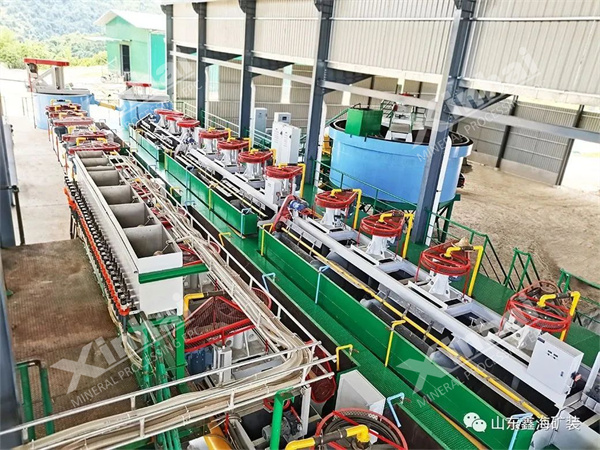Lithium mica is one of the important sources of lithium deposits, mainly produced in pegmatite type lithium deposits. Lithium mica is a layered aluminum silicate mineral with a dense structure and poor activity, making it difficult to react with acid and alkali at room temperature and pressure, making it difficult to recover. The mineral processing methods of lithium mica mainly include flotation, acid, alkali, salt, etc. In this article, we will introduce several recovery methods for lithium mica.

Lithium mica ore mostly belongs to the fine-grained intercalation type, and lithium mica mainly coexists with vein minerals such as quartz and feldspar. Fine grained lithium mica is mostly recovered through flotation. The reagent system is very important in the flotation recovery of lithium mica. Under acidic conditions, amine collectors are used for flotation of lithium mica, while under alkaline conditions, fatty acid collectors or combination collectors are used for flotation of lithium mica. In addition, the combination of anionic and cationic collectors can effectively improve the grade and recovery rate of lithium mica concentrate by utilizing the synergistic effect of reagents.
The acid method is commonly used in the extraction of lithium mica. Its principle is that hydrogen ions diffuse from the solution to the original silica film layer of lithium mica, causing it to decompose into soluble sulfates. According to different treatment methods, it can be divided into acid roasting method, concentrated sulfuric acid room temperature pretreatment method, and mixed acid treatment method.
According to the different types of acids, they can also be divided into sulfuric acid method and hydrofluoric acid method. The sulfuric acid method involves acidizing and roasting lithium mica and concentrated sulfuric acid at appropriate temperatures to obtain acidified clinker and then soaking it in water to obtain a lithium sulfate solution. After acidizing, the accompanying valuable metals rubidium and cesium become soluble salts. The process of using hydrofluoric acid for treatment is similar to sulfuric acid, with lower leaching temperature, shorter leaching time, and lower energy consumption, providing favorable conditions for subsequent impurity removal. On this basis, using a mixture of hydrofluoric acid and sulfuric acid for leaching can achieve a high leaching rate while reducing acid consumption.
The main method for extracting lithium mica by alkaline method is the limestone roasting method. The basic principle is to use alkali to dissolve SiO2 in solution. In alkali or gypsum, the silicate is converted into soluble lithium aluminate by heating, which reacts with a mixture of minerals and limestone or hydroxide to obtain lithium hydroxide or lithium carbonate.
The lepidolite concentrate and limestone are mixed in a certain proportion for ball milling and roasting at 800~900 ℃ to form clinker. The clinker is then subjected to water quenching, fine grinding, leaching, filtration or centrifugal separation to obtain leaching solution and residue. The concentration of lithium in the leaching solution is low, the evaporation of concentrated and recovered lithium is large, energy consumption is high, and valuable metal elements in the ore are leached into the leaching solution with lithium.
The sulfate roasting method is the most widely used method for extracting lithium in the salt process. The structure of lithium mica becomes loose after high-temperature calcination, and an ion exchange reaction occurs, that is, the metal ions in the added materials occupy the original lithium ion structure position, so that they can be separated from insoluble aluminosilicates to form soluble sulfate, which can be divided into sulfate roasting method, chlorination roasting method, sulfide roasting method, etc.
The sulfate roasting method exchanges cations in the sulfate with lithium ions, which are replaced and leached to obtain a lithium sulfate solution. The sulfate method has low impurity content, high leaching rate, good comprehensive metal recovery effect, and simple process. It has been widely used in the industrial production of lithium extraction from lithium mica. However, the sulfate method also needs to be completed after high-temperature calcination. During the high-temperature calcination process, fluorine and waste gas containing sulfides will evaporate, causing serious environmental pollution. Minerals are prone to stick together during the calcination process, reducing the calcination efficiency, and lithium products are prone to potassium pollution.
The chlorination roasting method converts lithium and other valuable metals in lithium mica into soluble chlorides, and leaches them to obtain a solution containing lithium, achieving the extraction of lithium and alkali metals. Chlorination roasting method can effectively shorten the time, produce less silicon aluminum slag and is easy to use, but chloride gasification will pollute the environment, using chlorine gas has higher operational risk, higher requirements for equipment corrosion prevention, resulting in increased production costs.
Sulfide roasting is the use of sulfides (such as Na2S and FeS) that can effectively extract lithium by leaching with water after roasting or grinding. The iron sulfide reagent used in this process is cheap, has low baking temperature, is environmentally friendly, has low impurity content, and has a relatively high leaching rate. However, in the experiment, the grinding time is long, and sulfur-containing compounds may evaporate into the atmosphere, causing air pollution.
The above are four methods for extracting lithium from lithium mica. In actual production, the recovery of lithium needs to consider multiple factors. For the production of mineral processing plants, understanding the composition and properties of minerals is very important. Based on this, using mineral processing experiments as a process flow method is relatively scientific and reasonable, which can effectively reduce investment losses.